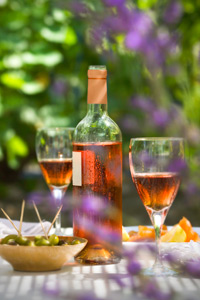“Wine should be an exciting experience from beginning to end – from the packaging to the story to the taste.” This comment, from the owner of an excellent new wine shop in the centre of Manchester, England, started me thinking. It can be so easy to fall into the habit of drinking the wines you know you like, from producers you know you can trust. I’m certainly guilty of that far too often. And if we do step out of our comfort zone, we tend to look to the New World for the most exciting young winemakers.
But one of the perks of my job is discovering wines that I might never have come across if they hadn’t been lined up in tastings run by importers or retailers, so I am highlighting here some of the most exciting young winemakers from old Europe. Some are from well known regions that can often be dismissed, such as Beaujolais, and others from emerging areas that deserve to be better known.
Chateau Haut Peyrous ‘Retour de Palombiere’ 2007, AOC Graves (approx £10)
Marc Darroze’s foodie credentials are pretty solid – the brother of Helene Darroze, Michelin-starred chef at the Connaught, and from a long line of chefs and restaurant owners. Marc has now been the owner of Chateau Haut Peyrous, in the Graves region of Bordeaux, since June 2008, and has just put his first white wines onto the market. Marc makes a selection of reds that have their foodie associations right up there on the label; a palombiere is a wood pigeon, and a second red is named after a local breed of pig. The whites are named after peaches, and the local oysters in Arcachon Bay.
Pinot Noir, Kendric Vineyard, Marin County 2006 (Miller Wine Works, approx US$40)
Gary Miller spent 12 years working in New York, Chicago and Aspen kitchens before migrating to Napa in 1999 and founding Miller Wine Works. Working with his wife Kim, they keep production small, high quality and food-focused – meaning thinking about things like good acidity, and not making wines that are so ‘big’ they drown out the food. Kendric Vineyard is located between Tomales Bay and San Francisco Bay, at about 200 metres elevation. The understanding of ingredients comes through in the subtle ways; like using seven different clones of pinot noir, all bringing a slightly different flavour profile. The wine itself has the wonderful gourmet sweetness of a good pinot noir, combined with a classic, almost austere structure that makes the whole thing delicate yet indulgent at the same time. And I love his food pairing suggestions on the website – the grilled halibut with this delicate wine was a great idea.
Tritono Malbec 2005, Mendoza Argentina (US$40)
The result of a collaboration between a New York-Italian restaurateur Joe Bastianich (who also owns his own wine estates in Friuli and Tuscany), Argentinean winemaker Matias Mayol and his Californian counterpart Steve Clifton (hence the name – a piece of music comprising three different tones – apparently you can find an example in the opening notes to Jimmy Hendrix’s Purple Haze!). Very nice depth to this wine, their second vintage, with some lovely spice and great complexity. The vineyards themselves are part of Mayol’s estates, and combine some very old vines (planted in 1926) in the Lujan de Cuyo region with younger vines from the Vista Flores district. No fining, no filtration, crying out for a good steak.
Bernat 2005 Estate Syrah, Santa Ynez Valley (US$40)
Sam Marmostein was a stockbroker before becoming a winemaker, but he now owns and runs the acclaimed Los Olivos Cafe and restaurant in California, meaning his foodie connections are right up there. His four acres of vines (making this the smallest licensed vineyard in the Santa Barbara area) are planted with Syrah, Nebbiolo, and Sangiovese, and he farms everything without the use of pesticides or herbicides. This natural approach extends through at all stages of the winemaking – there is no filtration or fining either, and the wine throws up a healthy deposit, as well as plenty of rich, round flavours of cracked black pepper, chocolate and blueberries.
2006 Wild Boar Doe, Shinn Estate Vineyards, New York State (approx US$40)
Owner David Page has spent almost 30 years in food, starting in California in the late 1970s and right now on the North Fork of Long Island in New York State. Something that I have noted with many of these foodie winemakers is how much care they take in their vineyards, and how much they lean towards organic, or at least sustainable, viticulture. No doubt because they know so much about the importance of raw ingredients – and no change here, where the vineyards are all about diversity of plant and animal life, and even the vines use several different clones for each variety (that are all vinified separately and blended at the end of ageing), and they use only organic fertilisers. This beautifully-named wine is a blend of malbec, cabernet sauvignon, merlot and petit verdot, and is rich but elegant, with melted tannins.
Paternus Cab Shiraz 2005 Ulithorne Wines, McLaren Vale (approx £40)
This winemaker, Rose Kentish, won Winemaker of the Year in McLaren Vale last year. She has a great foodie story – learning fast as a 17 year old cooking and governessing on a sheep station in central west Queensland, and later owning her own restaurant. The beautiful 19th century flour mill that she has restored with her artist husband now hosts various events that she still cooks for, but her main activity is making increasingly acclaimed and sought after bottles of wine. There is again a clear gourmet sensibility that carries through into her approach to wine-making; ‘lots of fruit but restrained use of oak and conscious focus on minimising alcohol’. This succulent mix of cabernet sauvignon and shiraz is a powerful, spicy and enormously distinctive wine.





